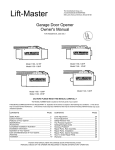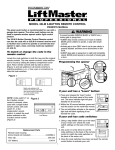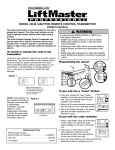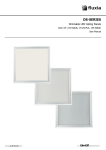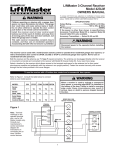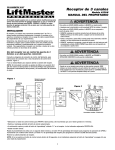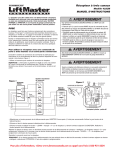Download Liftmaster 62LM LiftMaster
Transcript
Models 33LM, 33LMC, 61LM, & 61LMC To prevent possible SERIOUS INJURY or DEATH from a moving gate or garage door: • ALWAYS keep remote controls out of reach of children. NEVER permit children to operate, or play with remote control transmitters. • Activate gate or door ONLY when it can be seen clearly, is properly adjusted, and there are no obstructions to door travel. • ALWAYS keep gate or garage door in sight until completely closed. NEVER permit anyone to cross path of moving gate or door. Models 62LM & 62LMC Models 33LM, 33LMC 63LM, & 63LMC Models 64LM & 64LMC INTRODUCTION This product is for use with gate operators, commercial door operators and any LiftMaster® product that uses a 390 MHz fixed code. The single-button remote control will activate one device, the 2-button remote control will activate up to 2 devices, and the 3-button remote control will activate up to 3 devices. BEFORE YOU BEGIN Single and 3-Button Remote Controls Locate the dip switches on your remote control 2-Button Remote Control: The 2-button remote control has two sets of dip switches. Slide the battery cover open to access the dip switches for the smooth button. Remove the screw on the back of the remote control and remove the cover by pressing the tab. This will access the dip switches for the ribbed button. – 0 + 1 2 3 4 5 6 7 8 9 Single-Button and 3-Button Remote Controls: Slide the battery cover open to access the dip switches in the remote control. 2-Button Remote Controls 9 8 7 6 4 5 5 4 6 3 7 2 8 1 9 – 3 0 2 + 1 1 0 – 0 1 2 3 4 5 6 7 8 9 Mini Remote Controls + 3-Button Mini Remote Control: The large top button is recommended for use with a garage door opener and/or light control product. The other push buttons can be used to operate another garage door opener and/or light control product. Access the dip switches by turning the remote over and removing the back of the case. Be careful to avoid moving circuit board components. + – Tab PROGRAMMING Use a pen or screwdriver to slide the dip switches. Programming the remote control to an existing remote control Existing Remote Control 7 Locate the dip switches in the new and old remote controls. Place remote controls side by side and set the dip switches in the remote controls to matching positions (+,0,-). 7 8 8 9 9 New Remote Control 6 5 4 7 7 8 8 9 9 3-Button Remote Control 6 5 4 – 0 + 1 – 0 – 0 + + 1 1 2 2 3 3 4 5 6 = Dip switch #1 must correspond to the 3-button remote control buttons Programming the remote control without an existing remote control – 0 + – Single or 2-Button Remote Control Programming a 3-button remote control When programming a single or 2-button remote control to a 3-button remote control it is very important to set dip switch #1 to the correct position. The dip switch in the single or 2-button remote control MUST correspond to the buttons on the 3-button remote control as shown. Example: If you are programming a single-button remote control to the middle button on the 3-button remote control, dip switch #1 in the single-button remote control MUST be set to “0” in order for both buttons to work. 0 + 1 1 2 2 3 3 4 5 6 = + New Remote Control + 0 Set the dip switches in the remote controls to any position you want (+,0,-). – 1 2 3 4 5 6 7 8 9 Programming with Smart/Learn button 1 Press and release the Smart/Learn button on your product. The LED will light. 1 2 Smart/Learn Button 2 Within 30 seconds press and hold the button on the remote control that you wish to activate your product. Programming is complete. Repeat the steps above for each button and/or remote control you would like to program. Programming with dip switches 9 8 9 3 4 5 6 = 2 1 2 – 0 + 1 – 0 When the dip switches have been set press the remote control button to activate your product. 2 3 4 5 6 7 7 8 Use a pen or screwdriver to slide the dip switches in the remote control to match the dip switches on the back of the product. + 1 2 New Remote Control Dip Switch Settings From Product Check the dip switch settings on the back of your product. 0 - PROGRAMMING MODEL 33LM ONLY Install the control station and receiver where the door is visible, but away from the door and its hardware. When a receiver is used to activate a commercial door opener, a reversing edge MUST be installed on the bottom of the door. Failure to install a reversing edge under these circumstances may result in SERIOUS INJURY or DEATH to persons trapped beneath the door. Model 33LM 3-button remote controls can also be used with a 423LM 3-channel receiver and a 3-button door control to activate a commercial door operator in OPEN, CLOSE, and STOP mode. 1 Use a screwdriver to pry open the receiver cover. 2 Verify that the slide switch on receiver is set to the N.C. position (otherwise the commercial door operator will not operate). 3 Press and release the Smart/Learn button labeled “A” on the receiver. The adjacent LED will flash. 2 4 Within 30 seconds press and release the red button on the remote control. The red button is now programmed for CLOSE mode. NOTE: If the remote control button is not pressed within 30 seconds, the LED next to the selected Smart/Learn button will turn OFF. In that case, press the Smart/Learn button again to repeat programming. Slide Switch 1 N.C. 3 “A” Smart/Learn Button 4 Repeat the steps 3-4 above with the yellow button on the remote control and the receiver Smart/Learn button “B” to program the CLOSE mode; and again with the green button on the remote control and the receiver Smart/Learn button “C” to program the OPEN mode. 5 5 Replace the receiver cover. 3 THE REMOTE CONTROL BATTERY To prevent possible SERIOUS INJURY or DEATH: • NEVER allow small children near batteries. • If battery is swallowed, immediately notify doctor. The 12 volt battery should produce power for 1 year. Dispose of old batteries properly. NOTICE: To comply with FCC and or Industry Canada rules (IC), adjustment or modifications of this receiver and/or remote control are prohibited, except for changing the code setting or replacing the battery. THERE ARE NO OTHER USER SERVICEABLE PARTS. Tested to Comply with FCC Standards FOR HOME OR OFFICE USE. Operation is subject to the following two conditions: (1) this device may not cause harmful interference, and (2) this device must accept any interference received, including interference that may cause undesired operation. REPLACEMENT PARTS Visor clip . . . . . . . . . . . . . . . . . . . . . . . . . . . . . . . . . . . . . . . . . . . . . . . . . . . . . . . . . . . . . . . . . 29C128 12V battery . . . . . . . . . . . . . . . . . . . . . . . . . . . . . . . . . . . . . . . . . . . . . . . . . . . . . . . . . . . . . . . . 10A14 FOR TECHNICAL SUPPORT DIAL OUR TOLL FREE NUMBER: 1-800-528-9131 www.liftmaster.com 114A4172 © 2010 The Chamberlain Group, Inc. All Rights Reserved Modéles 33LM, 33LMC, 61LM, et 61LMC AVERTISSEMENT Afin d’éliminer les risques de BLESSURES GRAVES ou de MORT découlant de l’actionnement d’une clôture ou d’une porte de garage : • TOUJOURS garder les télécommandes hors de la portée des enfants. Ne JAMAIS laisser un enfant manipuler une télécommande ni jouer avec elle. • Actionner la clôture ou la porte UNIQUEMENT lorsqu’elle est clairement visible, correctement ajustée et que le mécanisme est libre de toute entrave. • TOUJOURS garder la clôture ou la porte de garage en vue jusqu’à sa fermeture complète. NE permettez à quiconque de passer lorsqu’une clôture ou une porte est en mouvement. Modéles 62LM et 62LMC AVERTISSEMENT Modéles 33LM, 33LMC, 63LM, et 63LMC ATTENTION Modéles 64LM, et 64LMC INTRODUCTION Ce produit est destiné à être utilisé avec des dispositifs de fermeture de barrières, des dispositifs de fermeture de porte commerciaux et avec tous les produits LiftMaster® qui utilisent un code fixe à 390 MHz. La télécommande à bouton unique activera un seul dispositif, la télécommande à 2 boutons activera jusqu’à 2 dispositifs et celle à 3 boutons en activera jusqu’à 3. AVANT DE COMMENCER Localisez les commutateurs Dip sur votre télécommande Télécommande à un bouton et à trois boutons : Glisser le couvercle du compartiment à piles afin d’accéder aux commutateurs de codes dans le télécommande. Télécommand à deux boutons : La télécommande à 2 boutons possède deux groupes de commutateurs Dip. – 0 + 1 2 3 4 5 6 7 8 9 Télécommande à un bouton et à trois boutons Télécommande à deux boutons 9 8 7 3 6 4 5 5 4 6 3 7 2 8 1 9 – 2 0 1 + 0 Onglet + – Glisser le couvercle du compartiment à piles afin d’accéder aux commutateurs de codes dans le bouton lisse. Démontez la vis au dos de la télécommande et retirez le couvercle en appuyant sur l’onglet. Ceci vous permettra d’accéder aux commutateurs Dip du bouton cannelé. Petit télécommande à trois boutons Accéder aux commutateurs de codes en retournant la télécommande et en retirant le dos du boîtier. S’assurer de ne pas déplacer les composants de la carte de circuit. 1 8 7 6 5 4 3 2 1 – 0 + Il est recommandé d’utiliser le gros bouton supérieur avec un ouvre-porte de garage ou une commande d’éclairage. Utiliser les autres boutons-poussoirs pour le fonctionnement d’un autre ouvreporte de garage ou commande d’éclairage. 9 Petit télécommande à trois boutons : A A PROGRAMMATION Utilisez un crayon ou un tournevis pour positionner les commutateurs Dip. Programmation de la télécommande avec une télécommande existante télécommande existante 7 Localisez les commutateurs Dip sur les télécommandes anciennes et nouvelles. Placez les télécommandes côte à côte et positionnez les commutateurs Dip sur chaque télécommande afin de correspondre aux positions (+, 0, -). 7 8 8 9 9 Nouvel télécommande Programmation d’une télécommande à 3 boutons Télécommande sans une ou deux boutons 6 5 4 – 9 Télécommande à 3 boutons 7 7 8 8 9 Lors de la programmation d’une télécommande à un seul ou à 2 boutons pour la transformer en une télécommande à 3 boutons, il est très important de positionner correctement le commutateur Dip n° 1. Le commutateur Dip de la télécommande à un seul ou à 2 boutons DOIT correspondre aux boutons sur la télécommande à 3 boutons comme sur la présentation. 0 + – 0 + 1 1 2 2 3 3 4 5 6 = Exemple : Si vous programmez une télécommande à un seul bouton sur le bouton central d’une télécommande à 3 boutons, le commutateur Dip n° 1 de la télécommande à un seul bouton DOIT être positionné sur « 0 » pour que les deux boutons puissent fonctionner. Commutateur Dip N° 1 doit correspondre aux boutons sur la télécommande à 3 boutons Programmation de la télécommande sans une télécommande existante 6 5 4 – 0 + – 1 – 0 0 + + 1 1 2 2 3 3 4 5 6 = + 0 Nouvel télécommande + 0 Réglez les commutateurs Dip des télécommandes sur n’importe quelle position (+, 0, -). – 1 2 3 4 5 6 7 8 9 Programmation avec bouton intelligent/d’apprentissage 1 Appuyez et relâchez le bouton Intelligent/d’apprentissage de votre produit. La DEL s’allumera. 2 Dans les 30 secondes, maintenez appuyé le bouton sur la télécommande que vous désirez utiliser pour activer votre produit. 1 Bouton intelligent/d’apprentissage 2 La programmation est terminée. Répétez les étapes ci-dessus pour chaque bouton et/ou chaque télécommande que vous désirez programmer. Vérifier la position des commutateurs Dip situés à l’arrière du produit. 3 4 5 6 = 2 3 4 5 6 7 7 8 8 9 Utiliser un stylo ou un tournevis pour modifier les positions des commutateurs de codes afin de les faire correspondre à celles des commutateurs situés à l’arrière du moteur. Nouvel télécommande 2 – 0 + 1 – 0 + Une fois les positions des commutateurs de codes établies, appuyer sur le bouton de télécommande afin d’activer l’unité. 1 2 1 2 La position des commutateurs Dip de produit 9 Programmation avec des commutateurs dip - PROGRAMMATION DU MODÈLE 33LM UNIQUEMENT AVERTISSEMENT Installer le poste de commande et le récepteur là où la porte est visible mais à l’écart de la porte et de ses ferrures de montage. Lorsqu’un récepteur est utilisé pour actionner un ouvre-porte commercial, une bordure d’inversion DOIT être posée au bas de la porte. L’omission d’une bordure d’inversion dans ces circonstances peut causer des BLESSURES GRAVES ou ORTELLES aux personnes se trouvant piégées sous la porte. AVERTISSEMENT AVERTISSE ATTENTION AVERTISSE Les télécommandes de modèle 33LM à 3 boutons peuvent aussi être utilisées avec un récepteur à trois canaux 423LM et un contrôle de porte à 3 boutons pour activer le dispositif de fermeture de porte commercial dans les modes OUVERTURE, FERMETURE et STOP. 1 Utiliser un tournevis pour soulever le couvercle du récepteur. 2 Vérifiez que le commutateur à glissière sur le récepteur est défini sur la position N.C. (sinon le dispositif de fermeture de porte commercial ne fonctionnera pas). 3 Ensuite et relâcher le bouton intelligent/d’apprentissage marqué « A » sur le récepteur. La DEL adjacente clignotera. 4 Dans les 30 secondes, appuyez et relâchez le bouton rouge de la télécommande. Le bouton rouge est dorénavant programmé sur le mode FERMETURE. 1 2 N.C. Commutateur à glissière 3 REMARQUE : Si un bouton-poussoir de la télécommande n’est pas enfoncé dans un délai de 30 secondes, le témoin lumineux adjacent au bouton « intelligent » sélectionné S’ÉTEINDRA. Il faut alors répéter la programmation. Bouton intelligent/d’apprentissage « A » 4 Répétez les étapes 3 - 4 ci-dessus avec le bouton jaune sur la télécommande et avec le bouton « B » Intelligent/ apprentissage du récepteur pour programmer le mode FERMETURE, et à nouveau avec le bouton vert de la télécommande et avec le bouton « C » Intelligent/apprentissage du récepteur pour programmer le mode OUVERTURE. 5 5 Remettez en place le couvercle du récepteur. 3 LES PILES DE TÉLÉCOMMANDE AVERTISSEMENT Pour prévenir d’eventuelles BLESSURES GRAVES ou LA MORT : • Ne JAMAIS laisser de petits enfants à proximité des piles. • Aviser immédiatement un médecin en cas d’ingestion de la pile. VERTISSEMENT La pile de 12 V devrait produire suffisamment de ATTENTION puissance pour au moins un an. AVERTISSE AVERTISSE Se débarrasser des vieilles piles convenablement. AVIS : Les règles de la FCC ou d’Industrie Canada (IC), ou les deux, interdisent tout ajustement ou toute modification de ce récepteur et ou de cet émetteur, sauf pour modifier le code ou pour remplacer la pile. IL N’EXISTE AUCUNE AUTRE PIÈCE SUSCEPTIBLE D’ÊTRE ENTRETENUE PAR L’UTILISATEUR. Vérifié pour conformité avec les normes de la FCC POUR UTILISATION À LA MAISON OU AU BUREAU. L’utilisation est sujette aux deux conditions ci-après : (1) ce dispositif ne peut causer des interférences nuisibles, et (2) ce dispositif doit accepter toute interférence reçue, y compris une interférence pouvant causer un fonctionnement non désiré. PIÈCES DE RECHANGE Pince du pare-soleil . . . . . . . . . . . . . . . . . . . . . . . . . . . . . . . . . . . . . . . . . . . . . . . . . . . . . . . . . . . . . . . . . . .29C128 Pile de 12 V . . . . . . . . . . . . . . . . . . . . . . . . . . . . . . . . . . . . . . . . . . . . . . . . . . . . . . . . . . . . . . . . . . . . . . . . . .10A14 POUR OBTENIR DE L’ASSISTANCE TECHNIQUE, COMPOSER NOTRE NUMÉRO GRATUIT : 1-800-528-9131 www.liftmaster.com 114A4172 © 2010 The Chamberlain Group, Inc. Tous droits réservés








